
 |
|||||
|
|
|||||
|
|
|
|||||
|
|
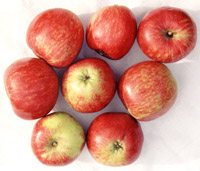 |
SIR ISAAC NEWTON'S TREE Also called The Gravity Tree and assumed, by some, to be the same as Flower of Kent (perhaps wrongly). Originating from a tree in the garden at Woolsthorpe Manor, nr Grantham, Lincolnshire, which belonged to Sir Isaac Newton's mother. Newton had gone from Cambridge University, to stay with his mother at Woolsthorpe when the university was closed, as the outbreak of plague spread from London. Folklore relates that he was sitting in the garden under an apple tree when the observation of the fall of an apple led to his theory of gravitation. There is no evidence that he was sitting at Woolsthorpe, or indeed sitting! History only records that his notion of gravity was occasioned by the fall of an apple. This famed and much visited tree eventually died in 1814 (and was confirmed as gone in 1820) though some maintain, from reports many decades after the demise, that it survived and re-grew. The evidence is strongly against this. Before its death, scions were taken from the tree to produce another tree in the garden of Lord Brownlow, at nearby Belton Manor. Material from this tree was used for further propagation. In the 1930s, East Malling Research Institute, attached to the National Fruit Trials, took wood from Belton Manor. At some point afterwards, it was assumed to be the same variety as Flower of Kent, which already existed in the National Fruit Trials, but they were kept separate up to 1971, at least, when the National Apple Register was published. They did not appear to be the same, and historical references certainly give cause to doubt that they were ever the same. Flower of Kent was in existence before 1629. The confusion is not helped by the nature of the Woolsthorpe tree, the fruit of which can vary considerably from year to year and month to month. Whether the original Flower of Kent is still to be found is uncertain, though it can still be found listed around the world and we have some trees, so named, here. The tree called Sir Isaac Newton’s Tree is a medium to large, green apple with variable red flushes and stripes. It is often ribbed but sometimes more rounded. Initially crisp, juicy and sharp when falling in October and early November, it is too acidic for dessert. If cooked at this stage, it does not break down, gives up little juice and has a light lemony flavour. Shortly after, it becomes a very rich dessert apple with a good blend of sweetness and acidity. It is still crisp, juicy and very fruity. This stage does not last beyond mid-December, when it starts to go softer and the flavour fades. Then it will cook to a fairly rich flavoured purée. It has also been used for cider. Trees are generally productive and regular bearers. T*. Pollination Group 6 |
||
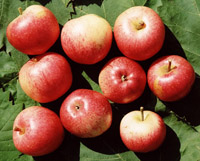 |
SKYRME’S KERNEL Forsyth (1810) and the National Apple Register (1971) have it as Skerm’s Kernel, but Hogg clearly attributes it to the Skyrme family and this should be the correct name. Hogg and Bull, in the Herefordshire Pomona (1876-85), say the Skyrmes were an old Herefordshire family and trees there were 100-150 years old at the time so it was probably raised before 1788, when the Skyrmes left their Bockhampton seat. Forsyth says it “is a conical-shaped middle-sized Apple, beautifully streaked with red, deepest towards the eye, and having a good deal of yellow towards the footstalk. It is ripe in January, and keeps till March.” It was deemed an attractive, late, conical culinary apple and also a cider variety, very highly reputed at the time. It had a strong flavour and darkened the cider, ‘even in the glass’. Hogg says the sunny side is bright crimson on a pale red ground, with streaks of crimson over pale yellow on the shady side. He calls it small, and with a slight waist towards the apex, the skin being smooth and shiny, the flesh firm, crisp but not very juicy. Trees are large and spreading. It was last officially known to exist in Britain in 1884, though the U.S. Department of Agriculture collection received it from England in 1948. Having discovered it there and receiving scions back, we grafted the first trees for reintroduction in 2005. The apple we have here accords fully with historical descriptions and is a very good apple. We find it perfectly pleasant to eat raw, it being firm, richly flavoured and sweet, if a little sharp. We have not yet make cider with it. Cooked, it softens fairly quickly and is sweet, lemony, full flavoured and would not want much, if any, sugar added. It is ripe in late October and will store for a few months. T*. Pollination Group 5 |
|||
SLACK-MA-GIRDLE
The Herefordshire Pomona of 1876-85, written by Hogg and Bull, includes
this apple under ‘local varieties’ and says “A striped
Somersetshire apple of large size. It is also much grown in Devonshire.
It keeps well and is usually sold for culinary purposes, though it often
helps to fill the barrel. As a cider apple, however, it has not much merit”.
It also gives a synonym of Slack-Ma-Girl. A prettily striped and red flushed
apple, ripe in October, and lasting until Christmas. It makes a large
tree with a spreading habit and is actually a passably good eating apple,
with a fair flavour and just the right balance of sugar and acid, with
enough juice. It cooks fairly quickly and develops a full, very rich,
tangy flavour, quite sweet enough without the need for added sugar. There
is no hint of tannin and it would have been of little value ‘to
fill the barrel’. Pollination Group 6 |
||||
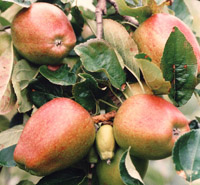 |
SMART’S
PRINCE ARTHUR A late nineteenth century cooking apple, raised
in 1883 by Mr Smart of Sittingbourne, Kent, and once much grown in the
orchards around Maidstone. Very attractive fruit with a distinctive tall,
conical shape; orange-yellow in colour, with deep red streaks. Known as
Lady’s Finger, in Kent. Yellow, juicy, sweetish flesh which develops
a fuller flavour with storage and becomes more of an eating apple. Cooked,
it keeps most of its shape. The tree has an attractive weeping habit.
Good Crops. Pick October and store until April. Pollination Group 5 |
|||
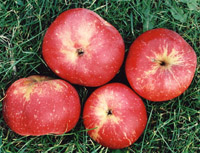 |
SOPS IN WINE There have been several different apples known by this name or similar variations. Parkinson in 1629 wrote ‘Sops in wine is so named both of the pleasantnesse of the fruit, and beautie of the apple’. It was recorded from 1826 in the three London Horticultural Society catalogues and described by Lindley, Hogg, Scott and Bunyard, over the decades. The descriptions and uses assigned suggest there was more than one known. Some writers call it a West Country or Devon apple, others suggest Sussex or Surrey. The one we offer here is from the Wisley collection. The name comes from the variable red-staining of the flesh, which might be patches under the skin or all the way to the core, as if bread sops were dipped in wine. The name and examples have also long existed in America. The medium sized apples have red skin in the shade, becoming very dark in the sun, 'and varnished rich deep chestnut', according to Hogg. The flesh is sometimes stained carmine. It has been considered a good culinary and cider fruit, though it is also a passable eater. The flesh is softish and not that sweet. Different writers suggest different seasons, but this one is a middle season apple, not lasting beyond November. Striking appearance and probably best suited to cider. Pollination Group 5 | |||
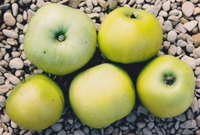 |
SPEEN
CHAPEL APPLE Named after Speen Baptist Chapel where this old
apple tree stands; a stately 47 feet tall and one of the tallest we have
seen. It was probably once even taller. The Chapel was one of the earliest
Baptist meeting houses (though the first Baptist church was built at Spitalfields
in 1612) and was constructed in 1802 by the villagers, the ladies of the
village bringing flints from the surrounding fields in their aprons. The
history of the immediate area is one of orchards and some trees remain.
The Speen Chapel Apple, however, has a separate history. Though now owned
by the Chapel, having been purchased in 2007, and within the ‘churchyard
grounds’, it was formerly one of those interesting village remnants,
marginalized when unenclosed village greensward succumbed to metalled
roadways. This small ground was once owned by the ‘House at Pye
Corner’ but separated by a road in modern times, hardly cultivated
for decades and recently wild, being wedged within two roads and the Chapel
ground. It was evidently used as garden or domestic orchard in the distant
past and we are grateful to Sandy Mitcheson, Joint Deacon of the Chapel
and to the Baptist Union for their help and access to their deeds, in
pursuit of the history of the land. Alas, the history can give no firm
evidence as to the age of this tree. Several years ago, Geoff Goodchild
took some cuttings and apples, which he passed to George Lewis and these
came to us, both gentlemen being dedicated to our joint purpose of seeking
out old trees and old varieties. We thank them both. The apples are medium
sized or a bit larger, pale green turning yellow when ripe and delicately
streaked with broken scarlet. The flesh is very juicy, tender and melting,
sweet and richly flavoured. When cooked, it keeps its shape, but its quality
is as a dessert apple. It is ripe in late September to mid October and
will store for a while. Large pink blossom. Pollination Group 3 |
|||
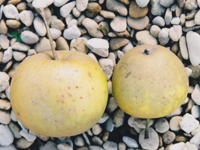 |
SPICE
RUSSET It is hard to know whether this exceptional apple is British
or American. It was noted in the supplemental list of Scott’s ‘The
Orchardist’ in 1872, and in 1883 an apple of this name was exhibited
at the National Apple Congress, at Chiswick, from Kidlington, near Oxford.
In America, it was described by Downing in 1876, drawing upon the earlier
description of Elliott, but no origin could be given. The description
given by Barron, from the National Apple Congress was of a culinary, medium
sized, round and angular apple with grey russet. He judged it ‘worthless’
but, then, he was inclined to use the word frequently in condemnation
of many a fine apple that he had seen only briefly, from fruit probably
picked too early to exhibit in mid-October, when it only ripens fully
in late November. Since it is a dessert apple, he might well have thought
it useless as an under-ripe culinary apple. We discovered this apple in
America and grafted new trees in 2010. It fruited in 2013. Medium sized,
round and slightly ribbed, often covered with thin grey russet and with
a thin, long stalk. Ripe from early to late November, the flesh is firm
rather than crisp, but juicy, very sweet and modestly acid, with a rich
flavour. The real surprise comes with the spicy aftertaste on the tongue
and back of the throat, though it is not always strong. It is hard to
name a specific spice, akin to the warming sensation. Pollination Group
4 |
|||
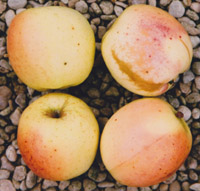 |
SPOTTED
PIPPIN In 1629, John Parkinson wrote in his Herbal, ‘The
spotted pippin is the most durable pippin of all the other sorts.’
The apple was not mentioned again until it appeared, without description,
in the catalogue of the London Horticultural Society of 1842. That was
the last sighting until, in 2009, we noticed it listed in the collection
of the late Nick Botner of Oregon, USA, and grafted new trees here. It
does not appear to have any recorded history in America and though it
could never be assumed to be the apple of Parkinson, with any certainty,
there remains a faint hope. It is certainly a late and lasting apple and
is delicately spotted, the spots becoming darker and more prominent as
the apples are kept. It is fully ripe only in November and keeps in fine
condition into the New Year. A rounded green apple, developing a warm
blush in the sun, with small but prominent spots. The flesh is crisp,
juicy and with a very rich floral flavour. Medium sweetness and low in
acid. A very good apple of mysterious provenance. Pollination Group 4 |
|||
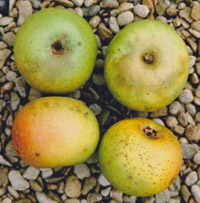 |
SPOUT
APPLE Found at Tibberton, Gloucestershire and of uncertain age.
A good, medium sized dessert apple, flat and round, yellow skinned, with
russet patches at the stalk and prominent dots. Late to ripen, in November,
it will store to January. A sweet, crisp, juicy apple with a refreshing
flavour, that becomes sweeter and richer with storage. Pollination Group
5 |
|||
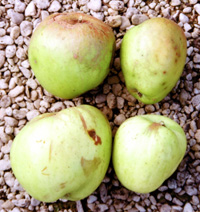 |
SPRING
GROVE CODLIN Sir Joseph Banks was a naturalist, botanist and
something of an explorer, accompanying Captain Cook on HMS Endeavour to
Australasia. He was later long serving President of the Royal Society
and was said to have brought 30,000 plants to the country and established
Kew Gardens as an international repository of flora. He was also a friend
of Thomas Andrew Knight, renowned pomologist of the West Country, who
bred this apple and offered the naming to Banks, who lived at Spring Grove,
near Hounslow, now London. Tim Henderson, while researching the papers
of Banks at the British Library, came upon an interesting reply from Banks
to Knight (10th March 1810) and he kindly passed it on to us. “You
do me honor & Flatter me much by allowing me to have the honor of
being God Father to your new apple Let him be if you please the Spring
Grove Codlin Spring Grove will then be rememberd when it shall become
a Part of the Town & instead of Sages ubi Troja there are houses where
Pepins usd to be”. Though this apple has been covered widely in
the old literature, the descriptions often vary. It has been called Springrove
Codlin by Hogg, though the correct name of Banks’ abode was Spring
Grove. Perhaps the fullest description is from George Lindley (1831) in
‘A Guide to the Orchard and Kitchen Garden’ “Fruit of
the usual codlin shape, about 3 inches in diameter at the base, and 2
inches and three quarters deep, slightly angular on its sides, and tapering
to a narrow crown. Eye closed by broad, short segments of the calyx, slightly
sunk in a narrow, oblique, plaited hollow. Stalk rather short, not protruding
beyond the base. Skin pale greenish yellow, tinged with orange on the
sunny side. Flesh greenish yellow, tender. Juice saccharine, with a mixture
of acid, and a very slight perfume. It is ready for tarts in July, and
will keep till October or November. The Spring Grove Codlin was first
brought into notice by Sir Joseph Banks, in a communication to the Horticultural
Society of London, read April 3rd 1810. Hogg (1884) said it “can
be used very early, when the fruit is no bigger than a walnut” but
that seems extreme. This apple has continuous history of existence up
to 1985 when it was still in the National Collection at Brogdale. However,
it was the habit there to re-propagate the collection every few years
and an error in the selection of the correct wood led to its loss there.
We had discovered it listed in the collection of the late Nick Botner
of Oregon and received scions in 2010. It is also supposedly still known
in Australia, if true to name, but it has been difficult getting co-operation
there to receive it for comparison. Initially our tree bore fruit that
seemed a little out with the various descriptions but, with the fruit
now having settled down, we are sure that it is true to name. We have
not cooked the apples when the size of a walnut. It is rather tough and
unpalatable raw at that stage. When ripe enough in September, it is not
really a great eating apple, but will cook slowly and keep its shape,
ending up with a sweetish, fairly rich, jelly-like consistency. In October
it becomes sweet enough for eating raw, with a hint of strawberries in
the flavour. Cooked, it is now very sweet and rich. In November it goes
soft and the flavour fades. Pollination Group 4 |
|||
|
||||